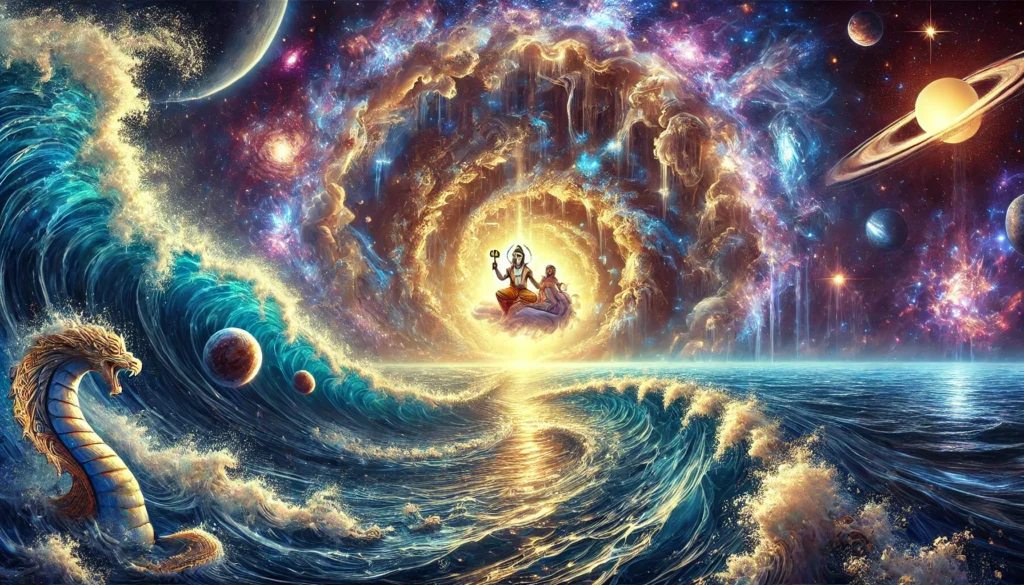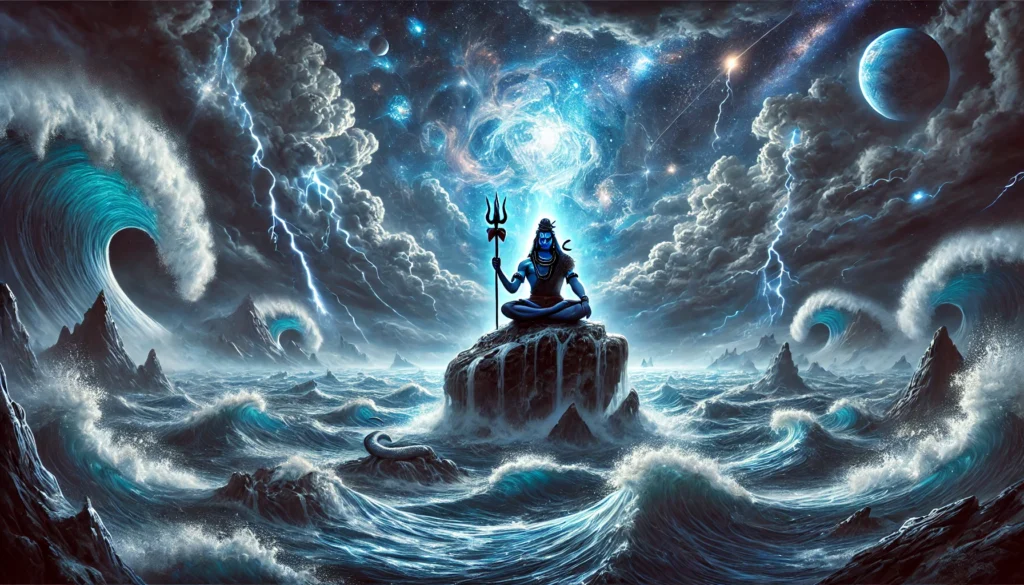Introduction: Unveiling the Depth of Hindu Mythology
Hindu mythology offers a vast reservoir of cosmic concepts, profound philosophy, and timeless wisdom. Among its captivating narratives, the tale of Samudra Manthan emerges as a cornerstone, entwined with the enigmatic metaphor of the Cosmic Ocean. This infinite expanse, representing the unmanifest potential of the universe, flows through ancient scriptures, philosophical teachings, and mythological lore, symbolizing creation, existence, and transcendence.
One of the most fascinating stories tied to the cosmic ocean is the Samudra Manthan, or the Churning of the Ocean. This myth is not only a narrative of divine collaboration and conflict but also a profound allegory for life’s challenges, cosmic balance, and spiritual awakening.
But what makes this story relevant even today? Could the myths of ancient India hold lessons for the modern world or even echo concepts from cutting-edge cosmology? Let’s dive deep into the cosmic ocean in Hindu mythology, starting with its origins in the Vedas and Puranas.

The Cosmic Ocean in Hindu Mythology
Lessons from Samudra Manthan: Balancing Creation and Destruction
The cosmic ocean is one of the most powerful symbols in Hindu philosophy. In the Rigveda, the oldest of the Vedas, the primordial waters are described as the foundation of creation. This infinite expanse is often portrayed as a state of potentiality—limitless, unmanifest, and eternal.
For instance, the Nasadiya Sukta of the Rigveda (10.129) describes a time before creation:
“In the beginning, there was neither existence nor non-existence; there was only darkness hidden by darkness. All that existed was an indistinct expanse of waters.”This cosmic ocean reappears across other sacred texts like the Vishnu Purana and Bhagavata Purana. In these, Lord Vishnu is often depicted reclining on the serpent Ananta, floating on the Garbodaka Ocean. This imagery symbolizes the cosmic equilibrium before creation—a state of balance and infinite possibilities.
Cycles of Creation and Destruction
The cosmic ocean also serves as a metaphor for the Hindu cyclic view of time—Srishti (creation), Sthiti (sustenance), and Pralaya (destruction). When the universe dissolves at the end of a cosmic age, it merges back into the primordial waters, only to be reborn again. The ocean thus embodies the eternal cycle of existence.
One Sanskrit verse encapsulates this beautifully:
“समुद्रः सर्वदेवतानां गर्भः” (Samudrah Sarvadevataanaam Garbhah)
—The ocean is the womb of all creation.
The Story of Samudra Manthan
The Symbolism of Samudra Manthan in Hindu Mythology
Among the countless tales of Hindu mythology, the Samudra Manthan stands out as a grand spectacle of cosmic proportions. It begins with the gods (Devas) and demons (Asuras) seeking the Amrit—the nectar of immortality. Despite their enmity, they form an uneasy alliance to churn the ocean and extract its divine treasures.
The gods and demons use the Mandara Mountain as the churning rod and the serpent Vasuki as the rope. Lord Vishnu, the preserver of the universe, assumes multiple roles to ensure the process unfolds smoothly. As the ocean is churned, a sequence of extraordinary events takes place.

Emergence of Treasures and Challenges
The churning of the ocean yields both boons and banes, symbolizing life’s dualities. Among the treasures that emerge are:
- Lakshmi, the goddess of wealth and prosperity.
- Kaustubha, a radiant gem that adorns Vishnu’s chest.
- Kalpavriksha, the wish-fulfilling tree.
- Kamadhenu, the divine cow.
However, not all outcomes are positive. The process also releases Halahala, a deadly poison capable of destroying all creation. Lord Shiva consumes this poison to save the universe, holding it in his throat, which turns blue—earning him the epithet Neelkanth.
Symbolism of the Samudra Manthan
The Samudra Manthan is more than a story of divine intervention; it is a profound allegory for human life and its struggles. The churning represents our efforts to extract wisdom and fulfillment from the chaos of existence. The poison symbolizes the inevitable challenges, while the nectar signifies the ultimate reward of persistence and balance.
Symbolism of the Cosmic Ocean
The cosmic ocean in Hindu mythology is a reservoir of profound symbolism. It represents not just the physical universe but also the realms of human consciousness and spirituality.
Metaphor for Human Consciousness
In spiritual traditions, the ocean’s vastness is often compared to the boundless nature of human consciousness. The process of churning the ocean mirrors the inner struggle of meditation and self-discovery. Just as the gods and demons collaborate to churn the ocean, humans must balance opposing forces within themselves—desires and discipline, ego and humility—to uncover higher truths.
The Yoga Vasistha, a philosophical text, beautifully captures this idea:
“The mind is like an ocean; its waves are thoughts. By calming these waves, one perceives the infinite depths of the Self.”
Relevance in Meditation Practices
The cosmic ocean also finds parallels in meditation, where practitioners are encouraged to still the “churn” of their thoughts to access the nectar of inner peace and enlightenment. The story of the Samudra Manthan serves as a metaphorical guide for this spiritual journey.

The Cosmic Ocean and Modern Cosmology
Parallels Between Myth and Science
Modern cosmology has uncovered mysteries of the universe that often echo ancient myths. The cosmic ocean can be likened to the space-time fabric of contemporary physics—a vast, incomprehensible expanse that holds the potential for stars, galaxies, and black holes to emerge.
The concept of the Big Bang, where creation arises from a singularity, mirrors the Hindu idea of creation arising from unmanifest waters. Similarly, quantum physics’ notion of infinite possibilities resonates with the Vedic description of the ocean as the source of all potential.
Insights from Carl Sagan and Other Thinkers
Renowned astrophysicist Carl Sagan, fascinated by Hindu cosmology, noted its striking similarities to modern science. In his book Cosmos, he remarked:
“The Hindu religion is the only one of the great faiths dedicated to the idea that the cosmos itself undergoes an immense, indeed an infinite, number of deaths and rebirths.”
This cyclic view aligns with scientific theories of multiverses and the cyclical nature of the cosmos.
Lessons from Samudra Manthan for Modern Times
The myth of Samudra Manthan offers timeless lessons that remain relevant in today’s world:
- Collaboration Despite Differences: The gods and demons, despite their inherent conflicts, come together for a common goal. This teaches us the value of unity and cooperation in addressing global challenges like climate change and social inequality.
- Facing Challenges Head-On: The emergence of Halahala reminds us that challenges are inevitable but can be mitigated through wisdom and courage, exemplified by Lord Shiva.
- Persistence and Patience: The prolonged churning of the ocean symbolizes the importance of perseverance in achieving goals, whether personal, professional, or spiritual.
FAQs About the Cosmic Ocean
1. What does the cosmic ocean symbolize in Hindu mythology?
The cosmic ocean represents the unmanifest potential of the universe, serving as the source of all creation and the symbol of infinity.
2. Why was the Samudra Manthan significant?
The Samudra Manthan symbolizes the balance of creation and destruction and highlights the importance of collaboration and persistence.
3. How does Hindu cosmology relate to modern science?
Hindu cosmology’s concepts of cyclic time, the cosmic ocean, and infinite potential align with scientific ideas like the Big Bang and quantum theory.
4. What items emerged from the churning of the ocean?
Notable items include Lakshmi, Kaustubha, Amrit, and Halahala, among others.
5. What is the role of Lord Vishnu in the Samudra Manthan?
Lord Vishnu plays a pivotal role by facilitating the process, assuming the forms of Kurma (tortoise) and Mohini (enchantress) to ensure the outcome benefits the gods.
Conclusion: The Eternal Depths of the Cosmic Ocean
The cosmic ocean is more than a mythical element; it is a profound metaphor for the universe, human consciousness, and the eternal cycles of existence. From the depths of the Samudra Manthan story to its echoes in modern science, the cosmic ocean continues to inspire and educate.
As we navigate the complexities of modern life, the lessons of collaboration, persistence, and balance from this ancient myth remain as relevant as ever. Let us embrace the wisdom of the cosmic ocean and explore its timeless depths, connecting mythology, spirituality, and science in our pursuit of truth and harmony.
What are your thoughts on the cosmic ocean? Share your reflections in the comments below and join the conversation!

Pingback: Why Did Shiva Drink Poison? Hidden Secrets of Divine Courage - Vedic Wars